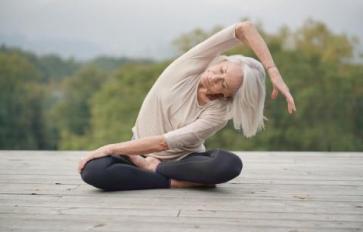
Crow pose: You start in a squat, from which flight seems unlikely. You lift your hips, plant your palms, place your knees on your upper arms, and then…well, often, nothing. Flight is scary—the fear of face planting keeps many people grounded.
How many times have you heard your yoga teacher say something akin to your practice being a microcosm of your behavior off the mat? We hope that if we can conquer our fear in bakasana, we’ll gain the skills to take flight in life. If we spend enough time balancing in tree pose, maybe that will translate to equilibrium in our everyday routines, aligning ambition and contentment, effort and release. We’ll finally figure out work-life balance.
Maybe.
But is it ever that simple, a one-to-one correspondence between a skill mastered in class and its nominal, off-the-mat twin?
Claire Dederer’s 2011 New York Times bestseller Poser: My Life in Twenty-Three Yoga Poses presents a more nuanced perspective on how a yoga practice can both reflect and shape a life.
Dederer begins practicing yoga when she throws out her back nursing her “delicious peach” of a daughter, “creamy and flushed and covered with fuzz.” But she’s also in search of achievable “goodness” and attainable goals, which motherhood, with its shifting rules and standards “as high as the moon,” is unable to offer.
Picture Seattle at the end of the last century, where to be a good mother you must shun strollers (the baby feels “alienated so far away from its mother”), use cloth diapers, buy expensive wooden toys, and sleep with your child in your bed.
“We were mothers with books,” Dederer writes. “We knew stuff, like, for example, that the American Academy of Pediatrics said that at least one year of nursing was optimal for the baby’s immune system and brain development. For the kind of mothers we were, optimal meant mandatory, and one year meant a few.”
For these liberal, educated, privileged women, motherhood seems to require selflessness, guilt, and perfectionism. Initially, it’s unclear whether Dederer’s yoga practice serves as a corrective to her hectic life or as an extension of it. Perfectionism doesn’t disappear once you step inside a studio. Neither does the urge to judge yourself against your neighbor.
The author wants to make herself virtuous from the outside in, pose by pose. Attempting to remove herself from the community’s impossible standards, Dederer merely recreates the essence of those standards on her mat.
Her self-imposed expectations are often hilariously high. She becomes obsessed with lotus and its “formal perfection,” and if you’ve ever fallen in love with a pose, you understand her hope that it might transform not only the shape of her body but the shape of her life. She writes, “the Buddha did lotus; you did lotus. I’m not saying I believed that the syllogism concluded with you turning into the Buddha, but still. At least you were working inside the same set of propositions.”
Obsessions with other asanas follow. Dederer’s descriptions of the emotional texture of poses are exquisite. Of balancing poses, she writes: “They made me feel strong and wonderful and like I had good hair.” It’s while her foot is behind her head and her hips are opening that Dederer realizes she doesn’t know “how to deal with having the tallest, saddest husband in the world.”
We all hope that yoga will make us better people, teaching us the skills to cope with the inevitable challenges of daily life. Rather than suggesting that a skill learned on the mat is directly transferrable off, the author highlights the line of correlation moving the other direction, pointing out that how we behave when practicing—our striving and comparing, our achievement-oriented goals and our unrealistic expectations—indicates how we’re approaching the other 23 hours of the day. Instead of turning to yoga for solutions, it might be more beneficial to ask what our practice can tell us about our problems.
Even if you haven’t directly experienced the challenges of motherhood or fatherhood, you can probably relate to some of Dederer’s perfectionism and her sense of oppression under suffocating expectations. This is a book for anyone who has ever hoped that mastering a pose, embodying perfection and goodness, would make them a more perfect human being.
It’s important to set high goals for yourself and dream big. But after reading this book, you may cross “goodness” off your list of intentions, wondering along with Dederer, “What if the opposite of good wasn’t bad? What if the opposite of good was real?”








